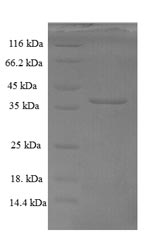Recombinant Drosophila melanogaster Bursicon is produced in an E. coli expression system, spanning the full length of the mature protein from amino acids 33 to 173. The product includes an N-terminal GST tag that helps with purification and detection. Purity levels appear to exceed 90%, as confirmed by SDS-PAGE analysis. This recombinant protein is designed for research use only and is free from detectable endotoxins, which likely makes it compatible with various experimental applications.
Bursicon acts as a neurohormone in Drosophila melanogaster, playing what seems to be a crucial role in post-molt processes—particularly in cuticle hardening and wing expansion. As part of the insect neuropeptide family, it appears to be involved in regulating physiological changes that occur during development. Studying bursicon's activity and interactions may provide valuable insights into the broader mechanisms of neurohormonal control in insects.
Potential Applications
Note: The applications listed below are based on what we know about this protein's biological functions, published research, and experience from experts in the field. However, we haven't fully tested all of these applications ourselves yet. We'd recommend running some preliminary tests first to make sure they work for your specific research goals.
Drosophila melanogaster Bursicon is a heterodimeric neurohormone that requires precise folding, proper disulfide bond formation, and heterodimerization with its partner protein (Burs β) for its functional activity in cuticle sclerotization and wing expansion. The E. coli expression system cannot provide the eukaryotic folding environment or the necessary partner protein for correct heterodimerization. The large N-terminal GST tag (∼26 kDa) is significantly larger than the bursicon subunit itself (33-173aa, ∼16 kDa), causing severe steric interference. The probability of correct folding with functional bioactivity is extremely low.
1. Antibody Development and Validation
This application is suitable as antibody generation relies primarily on linear epitope recognition. The mature protein region provides appropriate antigenic coverage. However, antibodies produced against potentially misfolded proteins may not optimally recognize conformation-dependent epitopes of native, properly folded bursicon in biological systems.
2. Biochemical Characterization and Structural Studies
Basic biophysical characterization can be performed, but will not reflect native bursicon structure. The GST tag will dominate all physical properties, and results will describe an artificial construct rather than the physiological heterodimer.
Final Recommendation & Action Plan
This GST-tagged bursicon fragment expressed in E. coli is unsuitable for functional studies due to the essential requirement for heterodimerization with its partner subunit, which cannot be met with this construct. The large GST tag relative to the protein size will dominate all structural and functional properties. For reliable bursicon research, co-express both subunits (Burs α and Burs β) in a eukaryotic system that supports proper heterodimerization and disulfide bond formation.




